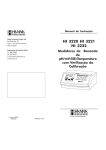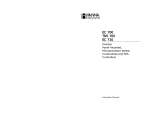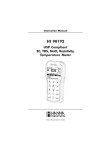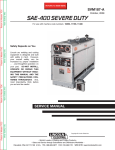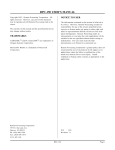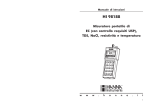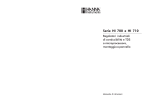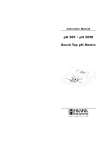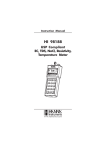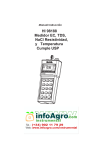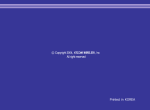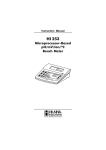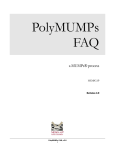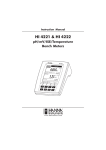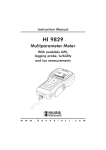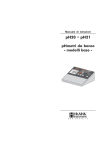Download HI 3512 - Hanna Instruments
Transcript
Instruction Manual HI 3512 Two Channels pH/ORP/ISE, EC/TDS/NaCl/Resistivity, Temperature Bench Meter w w w. h a n n a i n s t . c o m 1 Dear Customer, Thank you for choosing a Hanna Instruments product. Please read this instruction manual carefully before using this instrument. This manual will provide you with the necessary information for correct use of this instrument, as well as a precise idea of their versatility. If you need additional technical information, do not hesitate to e-mail us at tech@hannainst.com or view our worldwide contact list at www.hannainst.com. WARRANTY The HI 3512 is guaranteed for two years against defects in workmanship and materials when used for their intended purpose and maintained according to instructions. Electrodes and probes are guaranteed for six months. This warranty is limited to repair or replacement free of charge. Damage due to accidents, misuse, tampering or lack of prescribed maintenance is not covered. If service is required, contact the dealer from whom you purchased the instrument. If under warranty, report the model number, date of purchase, serial number and the nature of the problem. If the repair is not covered by the warranty, you will be notified of the charges incurred. If the instrument is to be returned to Hanna Instruments, first obtain a Returned Goods Authorization number from the Technical Service department and then send it with shipping costs prepaid. When shipping any instrument, make sure it is properly packed for complete protection. TABLE OF CONTENTS WARRANTY ................................................................................................................................ 2 PRELIMINARY EXAMINATION ....................................................................................................... 3 GENERAL DESCRIPTION ............................................................................................................... 3 FUNCTIONAL DESCRIPTION ........................................................................................................ 5 SPECIFICATIONS ........................................................................................................................ 7 OPERATIONAL GUIDE .............................................................................................................. 10 AUTO-RANGING EC CHANNEL .................................................................................................... 15 TEMPERATURE COMPENSATION EC CHANNEL ............................................................................. 16 CONDUCTIVITY VERSUS TEMPERATURE CHART ............................................................................ 17 USER CALIBRATION ................................................................................................................. 18 pH CALIBRATION .................................................................................................................... 19 pH BUFFER TEMPERATURE DEPENDENCE ................................................................................... 27 RELATIVE mV CALIBRATION ..................................................................................................... 28 ISE CALIBRATION ................................................................................................................... 29 EC CALIBRATION .................................................................................................................... 33 GOOD LABORATORY PRACTICE (GLP) .......................................................................................... 37 SETUP ................................................................................................................................... 40 LOGGING ................................................................................................................................ 55 mV CALIBRATION (for technical personnel only) ......................................................................... 58 TEMPERATURE CALIBRATION (for technical personnel only) .......................................................... 59 PC INTERFACE ........................................................................................................................ 61 TEMPERATURE CORRELATION FOR pH SENSITIVE GLASS ............................................................... 71 ELECTRODE CONDITIONING & MAINTENANCE ............................................................................ 72 EC PROBE MAINTENANCE ........................................................................................................ 75 TROUBLESHOOTING GUIDE ..................................................................................................... 76 ACCESSORIES ......................................................................................................................... 77 2 PRELIMINARY EXAMINATION Remove the instrument from the packing material and examine it carefully to make sure that no damage has occurred during shipping. If there is any damage, notify your Dealer or the nearest Hanna Customer Service Center. Each instrument is supplied with: • HI 1131B Glass body combination double-junction pH electrode • HI 76310 Four Ring Conductivity Probe with built-in temperature • HI 7662-T stainless steel Temperature Probe with 1 m (3.3') Cable • HI 70004 pH 4.01 Buffer Solution (20 mL sachet) • HI 70007 pH 7.01 Buffer Solution (20 mL sachet) • HI 700661 Cleaning solution (2x20 mL each) • HI 7071S Electrolyte Solution • HI 76404N Electrode Holder • 12 Vdc Power Adaptor • Instruction Manual HI 3512 is supplied with 12 Vdc/230 Vac power adapter HI 3512-01 is supplied with 12 Vdc/115 Vac power adapter Note: Save all packing material until you are sure that the instrument functions correctly. All defective items must be returned in the original packing with the accessories supplied. GENERAL DESCRIPTION The HI 3512 instrument is state-of-the-art, professional bench meter with graphical LCD, designed to provide laboratory results and accuracy. Two input channels are available. • Channel 1: pH/mV/ISE and temperature • Channel 2: EC/TDS, NaCl/Resistivity and temperature HI 3512 is provided with a series of new diagnostic features which add an entirely new dimension to the measurement of pH and EC, by allowing the user to dramatically improve the reliability of the measurement: pH channel: • 7 standard pH buffers (pH 1.68, 4.01, 6.86, 7.01, 9.18, 10.01 and 12.45) for calibration. • pH calibration up to five calibration points (see instrument specifications). • Custom calibration with up to two custom buffers. • Messages on the graphic LCD for an easy and accurate calibration. • Diagnostic features to alert the user when the electrode needs cleaning. • User selectable “Out of cal. range“ warning. • User selectable “Calibration Timeout“ to remind when a new calibration is necessary. 3 • Extended temperature range on pH channel from –20 to 120 ºC (–4 to 248 ºF), using HI 7662-T interchangeable temperature probes. EC channel: • 7 memorized standards (0.00 µS/cm, 84.0 µS/cm, 1.413 mS/cm, 5.00 mS/cm, 12.88 mS/cm, 80.0 mS/cm and 111.8 mS/cm) for calibration. • EC calibration up to two calibration points. • Messages on the graphic LCD for an easy and accurate calibration. • Diagnostic features to alert the user when the electrode needs cleaning. • User selectable “Out of cal. range” warning. • User selectable “Calibration Timeout” to remind when a new calibration is necessary. • Extended temperature range on EC channel from –20 to 120 ºC (–4 to 248 ºF), using temperature sensor inside EC probe. • Temperature compensation selection • Temperature reference selection 15 °C, 20 °C or 25 °C. • Temperature coefficient set • Lock and user setup Fixed range selection Other features include: • Log on demand up to 400 samples • Log interval with log on stability feature up to 600 records • Auto Hold feature, to freeze first stable reading on the LCD • GLP feature, to view last calibration data for pH, Rel mV, ISE, EC or NaCl. • PC interface This instrument can also measure with ORP electrodes (pH channel input), thanks to their capability to measure mV with a resolution up to 0.1 mV and with ISE electrodes on ppm scale (pH channel input). The electrode type and unit selection capability and the ISE calibration in up to five calibration standard solutions make this instrument very useful for a large range of concentration solutions measurements. Relative mV feature is also available. This instrument can also measure in Resistivity, TDS and Salinity on EC channel. 4 FUNCTIONAL DESCRIPTION Front view 1) Liquid Crystal Display (LCD) 2) Function keys 3) CHANNEL keys to toggle between channels (Ch1 - pH, Ch2 - EC) / keys to manually increase/decrease the parameters or to scroll 4) between the parameter list 5) MENU key, to change the function key at the bottom of the display 6) RANGE key, to switch between pH, mV and ISE range (Ch1); EC, Resitivity, TDS and Salinity range (Ch2) 7) HELP key to enter/exit contextual help 8) CAL key, to enter calibration mode 9) ESC to escape the current mode, exit calibration, setup, help, etc. 5 Rear view 10) 11) 12) 13) 14) 15) 16) ON/OFF switch. Power adaptor socket. USB connector. DIN connector for EC probe. BNC electrode connector for pH/ORP, ISE electrode. Temperature socket for pH/ORP, ISE channel. Reference electrode connector for pH/ORP, ISE channel. 6 SPECIFICATIONS –2.0 to 20.0 pH –2.00 to 20.00 pH –2.000 to 20.000 pH ±2000.0 mV Range 1.00 E-7 to 9.99 E10 conc. –20.0 to 120.0 ºC (4.0 to 248.0 ºF) Channel 1 000.1 pH 00.01 pH 0.001 pH Resolution 0.1 mV 3 digits 0.01, 0.1, 1, 10 conc. 0.1 ºC (0.1 ºF) ±0.01 pH ±0.002 pH Accuracy @ 20 ºC / 68ºF ±0.2 mV ±0.5% of reading (monovalent ions) ±1% of reading (divalent ions) ±0.2 ºC (±0.4 ºF) (excluding probe error) Rel mV offset range ±2000 mV pH Calibration Up to five-point calibration, 7 standard buffers available (1.68, 4.01, 6.86, 7.01, 9.18, 10.01, 12.45), and 2 custom buffers Slope Calibration From 80 to 110% pH Temperature Compensation Manual or Automatic from –20.0 to 120.0 ºC (–4.0 to 248.0 ºF) pH Electrode HI 1131B (included) Temperature probe HI 7662-T (included) ISE Calibration Up to five-point calibration points. 6 standard solutions available (0.1, 1, 10, 100, 1000, 10000 ppm) 7 000 to 400 mS/cm (shows values up to 1000 mS/cm) Actual conductivity 1000 mS/cm 0.001 to 9.999 µ S/cm 10.00 to 99.99 µ S/cm 100.0 to 999.9 µ S/cm 1.000 to 9.999 mS/cm 10.00 to 99.99 mS/cm .100.0 to 0999.9 mS/cm 1000 mS/cm (autoranging) Range EC 0.001 00.01 000.1 0.001 00.01 000.1 000.1 Resolution µ S/cm µ S/cm µ S/cm mS/cm mS/cm mS/cm mS/cm ±1% of reading (±0.01 µS/cm or 1 digit whichever greater) excluding probe error Accuracy 01.0 to 199.9 ohms .100 to 1.999 ohms 1.00 to 19.99 Kohms 10.0 to 199.9 Kohms .100 to 1.999 Kohms 1.00 to 19.99 Mohms 10.0 to 100.0 Mohms (autoranging) Range Resistivity Resolution 00.1 ohm 00.1 ohm 0.01 Kohms 0 0.1 Kohms 0.0 1 Kohms 0 0.01 Mohms 0 0.1 Mohms Accuracy ±1% of reading (±10 ohms or 1 digit whichever greater) excluding probe error 0.000 to 9.999 ppm 10.00 to 99.99 ppm 100.0 to 999.9 ppm 1.000 to 9.999 g/L 10.00 to 99.99 g/L 100.0 to 400.0 g/L (autoranging) Range TD S Resolution 0.001 ppm, 0.01 ppm, 0.1 ppm 0.001 g/L, 0.01 g/L, 0.1 g/L Accuracy ±1% of reading (±0.05 ppm or 1 digit whichever greater) excluding probe error 8 Range Salinity Temperature Channel 2 % NaCl: 0.0 to 400.0 % Resolution 0.1 % Accuracy ±1% of reading excluding probe error Range -20.0 to 120.0 °C Resolution 0.1 °C Accuracy ±0.2 °C (excluding probe error) Automatic up to 2 points with 7 memorized standards E C Calibration (0.00 µS/cm, 84.0 µS/cm, 1.413 mS/cm, 5.00 mS/cm, 12.88 mS/cm, 80.0 mS/cm, 111.8 mS/cm) Cell constant setup 0.010 to 10.000 NaCl Calibration Max. 1 point only (with HI 7073 standard); E C probe HI 76310 Temperature source Automatic from sensor inside the probe; Manual entry E C Temperature Compensation NoTC, MTC, ATC Reference Temperature 15, 20, 25 °C Temperature Coeficient 0.00 to 10.00 %/°C TD S Factor 0.40 to 1.00 LOG on demand 400 samples Lot logging 5, 10, 30 sec 1, 2, 5, 10, 15, 30, 60, 120, 180 min, AutoE nd (max 600 samples) Input impedance 1012 ohms Power supply 12 Vdc Power Adaptor PC interface opto-isolated USB D imensions 235 x 207 x 110 mm (9.2 x 8.14 x 4.33”) Weight (meter only) 1.8 Kg (4.1 lb) E nvironment 0 - 50 °C (32 - 122 °F) max. RH 55% non-condensing 9 OPERATIONAL GUIDE POWER CONNECTION Plug the 12 Vdc adapter into the power supply socket. Note: This instrument use non volatile memory to retain the pH, mV, Ion, EC, NaCl calibrations and all other settings, when unplugged. ELECTRODE AND PROBE CONNECTIONS For pH, ORP or ISE measurements connect a combination pH/ORP/ISE electrode to the BNC connector located on the rear panel of the instrument. For half cell electrodes with a separate reference connect the electrode’s BNC to the BNC connector and the electrode’s reference to the corresponding reference input socket. For temperature measurements and automatic temperature compensation on pH/ORP/ISE channel, connect the temperature probe to the appropriate socket. For EC, TDS, NaCl or Resistivity measurements connect the EC probe to the DIN connector located on the rear panel of the instrument. As the channels are fully isolated and a temperature probe is connected on pH channel you can view independent temperature readings on each channel. INSTRUMENT START UP • Turn the instrument ON by pressing ON/OFF switch located on the rear panel of the instrument. • At start-up the display will show the Hanna logo for a few seconds followed by the “Loading Log” message, then enters the measurement mode. pH MEASUREMENTS To take a pH measurement remove the electrode protective cap and simply submerse the electrode and the temperature probe 3 cm (1¼”) into the sample to be tested. If necessary, press CHANNEL to select pH channel 3 cm or/and press RANGE until the display changes to the pH mode. Enter SETUP menu to select the pH resolution. 10 Allow for the electrode to adjust and reading to stabilize (hourglass symbol turns off). On the pH screen are displayed: • pH reading with the selected resolution. • Temperature reading in the selected unit (ºC or ºF). • Temperature compensation mode (MTC - manual, ATC - automatic). While in MTC mode the indicate that the temperature can be manually changed using ARROW keys. • Electrode condition during the calibration day. • The buffers used in last pH calibration (if feature is enabled in SETUP). • Available function keys. In order to take more accurate pH measurements, make sure that the instrument is calibrated (see page 19 for details). It is recommended that the electrode is always kept wet and rinsed thoroughly with the sample to be measured before use. The pH reading is directly affected by temperature. For accurate pH measurements, temperature must be taken into consideration. If the sample temperature is different from the temperature at which the pH electrode was kept, allow a few minutes to reach thermal equilibrium. To use the instrument's Automatic Temperature Compensation feature, submerse the temperature probe into the sample as close to the electrode as possible and wait for a few seconds. If manual temperature compensation (MTC) is desired, the temperature probe must be disconnected from the instrument. The display will show the last measured temperature reading, or the last set temperature, with the “MTC” indication. The “MTC” indication and the symbol light up on the LCD to indicate that the instrument is in MTC mode and the ARROW keys can be used to enter the desired temperature value. Note: When in MTC mode the user can press and hold an ARROW key, and the instrument will start incrementing/decrementing the temperature value. The instrument keeps measuring and the display is updated periodically. 11 ORP MEASUREMENTS To perform ORP measurements, connect an ORP electrode (see ACCESSORIES section) to the instrument and turn it ON. If necessary, enter the mV mode by pressing RANGE until the display changes to mV. Submerse the ORP electrode 3 cm (1¼”) into the 3 cm sample to be tested and wait a few seconds for the reading to stabilize. Measurements are displayed with 0.1 mV resolution. The “ATC” (or “MTC”) message is turned off because mV readings are not temperature compensated. For accurate ORP measurements, the surface of the electrode must be clean and smooth. Pretreatment solutions are available to condition the electrode and improve its response time (see ACCESSORIES section, page 77). RELATIVE mV MEASUREMENTS To enter Relative mV mode, press Rel mV function key while in mV measurement mode. The relative mV reading will be displayed along with the Absolute mV value and the current temperature readings. The relative mV reading is equal to the difference between the absolute mV input value and relative mV offset established in the relative mV calibration. Note: If using the pH or ISE electrode while in mV mode, the instrument will measure the mV generated by the electrode. ISE MEASUREMENTS To perform ion concentration measurements, connect an ISE electrode (and the corresponding reference if necessary) to the corresponding BNC input and turn it ON. 12 Submerse the ISE electrode tip 3 cm (1¼”) into the sample to be tested and wait for the reading to stabilize. The ISE reading will be displayed along with the current temperature reading. 3 cm The ”ATC“(or “MTC”) message is turned off because ppm readings are not temperature compensated. In order to take accurate ISE measurements, make sure that the appropriate ISE electrode type and ISE unit were set in SETUP menu and the instrument was calibrated (see ISE CALIBRATION for details, page 29). Notes: • When the reading is out of range, the display will flash the closest full-scale value. • The instrument will display “----” on the primary LCD if it is not calibrated. Perform at least a single-point calibration in order to take ISE measurements. • Changing the selection in the SETUP menu for the ISE electrode or the ISE parameter will require calibration. TEMPERATURE MEASUREMENTS pH channel Connect the HI 7662-T temperature probe to the appropriate socket. Immerse the temperature probe into the sample and allow the reading on the secondary LCD to stabilize. Note: The temperature can be displayed in Celsius degrees (ºC) or in Fahrenheit degrees (ºF) (see SETUP for details, page 40). EC/TDS/NaCl/Resistivity channel Immerse the conductivity probe (which includes also the temperature sensor) into the solution to be tested. The sleeve holes must be completely submerged. Tap the probe repeatedly to remove any air bubbles that may be trapped inside the sleeve. If needed, press CHANNEL to select EC channel or/and press RANGE repeatedly until the desired range (EC, Resistivity, TDS, Salt) is selected on the LCD. If needed, select the “Automatic” or “No TC” compensation mode to perform temperature measurements (see SETUP for details, page 40). Allow for the reading to stabilize. The main LCD line displays the measurement in the selected range, while the temperature is displayed on the lower LCD line. 13 EC range The conductivity range is from 0 to 400 mS/cm . The actual conductivity range (the uncompensated conductivity) is up to 1000 mS/cm. The instrument will display conductivity readings up to 1000 mS/cm. Note: The symbol in front of the temperature reading means that the temperature can be entered by the user (“Manual” option selected in SETUP). Resistivity range The reciprocal of the conductivity of a material is the resistivity. TDS range A conductivity measured value can be corrected to a total disolved solids value using the TDS factor (value entered in SETUP). Salinity The salinity is derived from the conductivity of a sample. The percent of salinity in a sample is depending of the sample and on the salinity coefficient. 14 AUTO-RANGING EC CHANNEL The EC, Resistivity and TDS scales are auto-ranging. The meter automatically sets the scale with the highest possible resolution. By pressing Lock, the auto-ranging feature is disabled and the current range is frozen on the LCD. The “Range: Locked” message is displayed. To restore the auto-ranging option press AutoRng functional key again. The auto-ranging mode is also disabled by selecting a “fixed range” in the SETUP menu. While in fixed range mode the instrument will display the readings with the fixed resolution. Maximum 6 digits can be displayed. The top of the fixed range is displayed blinking when the reading exceeds this value. To disable fixed range mode enter SETUP and select auto-ranging mode. Note: Auto-ranging is automatically restored if the range is changed, if the meter is turned off and back on again or if the calibration mode is entered. 15 TEMPERATURE COMPENSATION EC CHANNEL The conductivity of a solution with a specific electrolyte concentration changes with temperature. The relationship of the change in conductivity as a function of temperature is described by a solution’s temperature coefficient. This coefficient varies with each solution and is user selectable (see SETUP mode). Two selectable temperature sources are available: reading directly from the sensor inside the probe or manual entry. Three options of linear temperature compensation are available: Automatic: temperature readings from the sensor inside the EC probe. Manual: temperature entered manually by the user. No Temperature Compensation (No TC): The temperature shown on the LCD is not taken into account. The meter displays the actual conductivity. To select the desired option enter SETUP menu (see page 40). If the temperature is out of the -20 °C - 120 °C range the instrument will not do temperature compensation. 16 CONDUCTIVITY VERSUS TEMPERATURE CHART The conductivity of an aqueous solution is the measure of its ability to carry an electrical current by means of ionic motion. The conductivity invariably increases with increasing temperature. It is affected by the type and number of ions in the solution and by the viscosity of the solution itself. Both parameters are temperature dependent. The dependency of conductivity on temperature is expressed as a relative change per Celsius degree at a particular temperature, commonly as percent per ºC. The following table lists the temperature dependence of the HANNA calibration buffers. ºC ºF 0 5 10 15 16 17 18 19 20 21 22 23 24 25 26 27 28 29 30 31 32 41 50 59 60.8 62.6 64.4 66.2 68 69.8 71.6 73.4 75.2 77 78.8 80.6 82.4 84.2 86 87.8 HI7030 HI7031 HI7033 HI7034 HI7035 HI7039 HI8030 HI8031 HI8033 HI8034 HI8035 HI8039 (µS/cm) (µS/cm) (µS/cm) (µS/cm) (µS/cm) (µS/cm) 7150 8220 9330 10480 10720 10950 11190 11430 11670 11910 12150 12390 12640 12880 13130 13370 13620 13870 14120 14370 776 896 1020 1147 1173 1199 1225 1251 1278 1305 1332 1359 1386 1413 1440 1467 1494 1521 1548 1575 64 65 67 68 70 71 73 74 76 78 79 81 82 84 86 87 89 90 92 94 48300 53500 59600 65400 67200 68500 69800 71300 72400 74000 75200 76500 78300 80000 81300 83000 84900 86300 88200 90000 65400 74100 83200 92500 94400 96300 98200 100200 102100 104000 105900 107900 109800 111800 113800 115700 117700 119700 121800 123900 2760 3180 3615 4063 4155 4245 4337 4429 4523 4617 4711 4805 4902 5000 5096 5190 5286 5383 5479 5575 BACKLIGHT FEATURE The instrument is provided with a Backlight feature. The Backlight levels can be selected in the SETUP menu. 17 USER CALIBRATION To enter User Calibration screen press CAL key while in pH/Rel mV/ISE range (pH channel) or EC/Salinity range (EC channel). From EC range Press the corresponding functional key to enter: • EC user calibration. • Ch2 temperature user calibration. From pH range Press the corresponding functional key to enter: • pH user calibration. • Ch1 temperature user calibration. Note: For REL mV, ISE or Salinity range, pressing CAL on the selected range will cause the meter to enter directly in calibration mode. 18 p H CALIBRATION It is recommended to calibrate the instrument frequently, especially if high accuracy is required. The pH range should be recalibrated: • Whenever the pH electrode is replaced. • At least once a week. • After testing aggressive chemicals. • When calibration alarm time out is expired - “CAL DUE” blinks (if feature is enabled in SETUP). • If “Out of cal. range” message appears on the LCD during pH measurement (the measurement range is not covered by current calibration, if this feature is enabled in SETUP). PROCEDURE The HI 3512 offers a choice of 7 standard buffers (1.68, 4.01, 6.86, 7.01, 9.18, 10.01 and 12.45 pH) and up to 2 custom buffers. The standard pH buffers are temperature compensated during calibration. The custom, user entered buffers are not temperature compensated during calibration. When a custom buffer is selected during calibration, the Custom function key is displayed on the LCD. Press Custom key in order to alter the value to the actual pH value at the temperature of measurement. Use ARROW keys to change the value within a ±1.00 pH window and then press Accept. Press ESC to leave custom buffers value unchanged. Press Confirm. For accurate pH measurements, it is recommended to perform a multipoint calibration. At least a two-point calibration is required. The instrument will automatically skip the buffers within ±0.2 pH window, around one of the calibrated buffers. • Pour small quantities of selected buffer solutions into clean beakers. For accurate calibration use two beakers for each buffer solution, the first one for rinsing the electrode and the second one for calibration. • Remove the protective cap, open the fill hole and rinse the electrode with some of the buffer solution to be used for the first calibration point. 19 FIVE-POINT CALIBRATION • Immerse the pH electrode and the temperature probe approximately 3 cm (1¼”) into a buffer solution of your choice (pH 1.68, 4.01, 6.86, 7.01, 9.18, 10.01, 12.45 or a custom buffer) 3 cm and stir the buffer gently. The temperature probe should be close to the pH electrode. • Enter pH calibration. The instrument will display the measured pH, the LCD first expected buffer and the temperature reading. • If necessary, press the ARROW keys to select a different buffer value. • The “ ” tag will blink on the LCD until the reading is stable. • When the reading is stable and close to the selected buffer, Confirm function key is displayed. • Press Confirm to confirm first point. • The calibrated value and the second expected buffer value is then displayed on the LCD. • After the first calibration point is confirmed, immerse the pH electrode and the temperature probe approximately 3 cm (1¾”) into the second buffer solution and stir gently. The temperature probe should be close to the pH electrode. • If necessary, press the ARROW keys to select a different buffer value. • The “ ” tag will blink on the LCD until the reading is stable. 20 • When the reading is stable and close to the selected buffer, the Confirm function key is displayed. • Press Confirm to confirm calibration. • The calibrated value and the third expected buffer value will be displayed. • After the second calibration point is confirmed, immerse the pH electrode and the temperature probe approximately 3 cm (1¾”) into a third buffer solution and stir gently. The temperature probe should be close to the pH electrode. • If necessary, press the ARROW keys to select a different buffer value. • The “ ” tag will blink on the LCD until the reading is stable. • When the reading is stable and close to the selected buffer, the Confirm function key is displayed. • Press Confirm to confirm calibration. Repeat this procedure with two additional pH buffers to encompass the entire sample pH range. 21 FOUR, THREE or TWO-POINT CALIBRATION • Proceed as described in “FIVE-POINT CALIBRATION” section. • Press ESC after the appropriate accepted calibration point. The instruments will return to calibration screen and will memorize the calibration data. SINGLE-POINT CALIBRATION There are two selectable options for a single-point calibration: Replace and Offset. This option is configured in SETUP mode under the parameter First Point Mode. In both cases the meter will alter the present calibration data in the instrument. If “Replace” is selected a new calibration point will be added to the existing data, and the slope is calculated. The slopes between current buffer and nearest lower and higher buffers will be reevaluated. If the “Offset” option is selected, an electrode offset correction is performed to all buffer data keeping the existing slopes unchanged. • Proceed as described in “FIVE-POINT CALIBRATION” section. • Press ESC after the first calibration point was confirmed. The instruments will memorize the single-point calibration data and will return to calibration screen. Notes: • Press MTC key to toggle between pH buffer selection and the temperature reading during calibration while temperature probe is disconnected (MTC mode). • The displayed arrow is moving to the temperature value. Use ARROW keys in order to change the temperature. ERROR SCREENS Wrong temperature The calibration cannot be confirmed. If the temperature is less than 0 °C or greater than 100 °C during calibration, the calibration cannot be confirmed. 22 Wrong buffer The calibration cannot be confirmed. The pH reading is not close to the selected buffer. Select another buffer using the ARROW keys or change the buffer. “Electrode Dirty/Broken“ alternatively with “Buffer Contaminated“. The calibration cannot be confirmed. The offset of the electrode is not in the accepted range. Check if the electrode is broken or clean it following the CLEANING PROCEDURE (see page 74). Check the quality of the buffer. If necessary, change the buffer. Wrong slope The calibration cannot be confirmed. The evaluated slope is less than the lowest accepted value (80% of default slope). The evaluated slope is more than the highest accepted value (110 % of default slope). 23 Wrong old slope An inconsistency between new and previous (old) calibration is detected. Clear old calibration parameters and initiate calibration from the current point. The instrument will keep all confirmed values during current calibration. Note: For single-point calibration the electrode condition is not displayed in the measurement screen. Each time a buffer is confirmed, the new calibration parameters replace the older calibration parameters of the corresponding buffer. If an additional single buffer calibration is added at a latter time, the new buffer point will be added to the stored calibration. If the existing stored calibration is full (five calibration points), after confirming the calibration point, the instrument will ask which buffer will be replaced by current buffer. On the Buffer line will be displayed the proposed buffer. Press ARROW keys to select another buffer to be replaced. Press Confirm to confirm the buffer that will be replaced. Press ESC to exit mode. In this case, the buffer will not be entered. Note: The replaced buffer is not removed from calibration list and it can be selected for the next calibration points. WORKING WITH CUSTOM BUFFERS If at least one custom buffer was set in SETUP menu, it can be selected for calibration by pressing the ARROW keys. The Custom function key will be displayed. Press Custom if you want to adjust the buffer to its value at the current temperature. 24 Use the ARROW keys to change the buffer value. Press Accept to accept new value or ESC to exit mode. Note: Custom buffer value can be adjusted within a ±1.00 pH window, around the set value. WORKING WITH MILI pH BUFFERS HANNA millesimal pH buffers are ± 0.002 pH buffers formulated to correspond to nominal pH values. (1.000, 2.000, 3.000, 4.010, 5.000, 6.000, 7.010, 8.000, 9.000, 10.010, 11.000, 12.000, 13.000 and 9 that fall between). These buffers require the user to use the closest standard buffer and adjust it, or to use custom buffers. With these buffers it is possible to closely bracket the measurement range of interest and insure an accurate measurement. The resolution of the meter must be set to 0.001 pH (see SETUP on page 40). Eight buffers are stored in instrument for calibration. If calibration is invoked using millesimal buffers, the calibration buffer can be modified within a ±0.020 pH range in accordance with the label on the calibration buffer. Press Change to enter buffer adjust mode. Use ARROW keys to change the buffer value. Press Accept to accept new value or ESC to exit adjusting mode. CLEAR CALIBRATION Press Clear function key when displayed to clear previous calibrations. 25 The instrument will display “Calibration Cleared” and the instrument returns to measuring mode. ELECTRODE CONDITION The display is provided with an icon, and a numeric value (unless the feature is disabled) which gives an indication of the electrode status after calibration. The indication remains active until the end of the calibration day. Note: The electrode condition is evaluated only if current calibration includes at least two standard buffers. CLEAN ELECTRODE WARNING Each time pH calibration is performed, the instrument internally compares the new calibration with the one previously stored. When this comparison indicates a significant difference, the “Clean Electrode” warning message is displayed to advise the user that the pH electrode may need to be cleaned (see ELECTRODE CONDITIONING & MAINTENANCE section for details, page 72). After cleaning, perform a new calibration. Note: If the calibration data are cleared, the comparison is done with the default values. 26 p H BUFFER TEMPERATURE DEPENDENCE Temperature has an effect on pH buffers. During calibration the instrument will automatically calibrate to the pH value corresponding to the measured or set temperature. TEMP pH BUFFERS ºC ºF 1. 68 4. 01 6. 86 7. 01 9. 18 10. 01 12. 45 0 32 1.67 4.01 6.98 7.13 9.46 10.32 13.38 5 41 1.67 4.00 6.95 7.10 9.39 10.24 13.18 10 50 1.67 4.00 6.92 7.07 9.33 10.18 12.99 15 59 1.67 4.00 6.90 7.05 9.27 10.12 12.80 20 68 1.68 4.00 6.88 7.03 9.22 10.06 12.62 25 77 1.68 4.01 6.86 7.01 9.18 10.01 12.45 30 86 1.68 4.02 6.85 7.00 9.14 9.96 12.29 35 95 1.69 4.03 6.84 6.99 9.11 9.92 12.13 40 104 1.69 4.04 6.84 6.98 9.07 9.88 11.98 45 113 1.70 4.05 6.83 6.98 9.04 9.85 11.83 50 122 1.71 4.06 6.83 6.98 9.01 9.82 11.70 55 131 1.72 4.08 6.84 6.98 8.99 9.79 11.57 60 140 1.72 4.09 6.84 6.98 8.97 9.77 11.44 65 149 1.73 4.11 6.84 6.99 8.95 9.76 11.32 70 158 1.74 4.12 6.85 6.99 8.93 9.75 11.21 75 167 1.76 4.14 6.86 7.00 8.91 9.74 11.10 80 176 1.77 4.16 6.87 7.01 8.89 9.74 11.00 85 185 1.78 4.17 6.87 7.02 8.87 9.74 10.91 90 194 1.79 4.19 6.88 7.03 8.85 9.75 10.82 95 203 1.81 4.20 6.89 7.04 8.83 9.76 10.73 During calibration the instrument will display the pH buffer value at 25 ºC. 27 RELATIVE m V CALIBRATION The relative mV value calibration may be used to perform a single point calibration with an ORP standard or remove the contribution of the reference electrode to display mV equivalent to a SHE. • Press CAL when the instrument is in Relative mV measurement mode. The relative mV value and the temperature values are displayed. • Use the ARROW keys if you want to change the displayed relative mV value. • Press Zero function key if you want Rel mV reading to be zero (Relative mV offset equals the mV reading). • When the reading is stable in mV range and the Relative mV offset is inside the offset window (±2000 mV), the Confirm function key is displayed. • Press Confirm to confirm relative mV calibration. The instrument will return to measurement mode. • If the absolute mV reading is out of range or the Relative mV offset is out of the offset window, “Wrong relative offset” message is displayed. Change the input value or the Relative mV value to complete the calibration process. Note: If a Rel mV offset calibration exists, CLR function key is displayed. Press CLR if you want Rel mV offset to be 0.0 mV. 28 I S E CALIBRATION It is recommended to calibrate the instrument frequently, especially if high accuracy is required. The ISE range should be recalibrated: • Whenever the ISE probe or ion charge is changed. • At least once a day. • After testing aggressive chemicals. • When calibration alarm time out is expired- “CAL DUE” warning blinks (if feature is enabled). Follow instructions for the individual electrode. Due to electrode conditioning time, the electrode must be kept immersed a few seconds to stabilize. The user will be guided step by step during calibration with easy to follow messages on the LCD. This will make the calibration a simple and error-free procedure. PROCEDURE Select the proper ISE probe in SETUP menu or select the proper Ion Charge slope (see SETUP for details, page 40). Note: If the ISE probe has not been previously calibrated (at least one point), the “----” will be displayed. Pour small quantities of the buffer solutions into clean beakers. If possible, use plastic beakers to minimize any EMC interferences. For accurate calibration and to minimize cross-contamination, use two beakers for each standard solution. One for rinsing the electrode and one for calibration. The HI 3512 permits a 5 point calibration in 6 standard solutions (0.1, 1, 10, 100, 1000, 10000). It is advised to bracket expected ion concentration with your standards. For fluoride electrode the 2 ppm standard is also available. For accurate ISE measurements it is recommended to perform a multipoint calibration. At least a two-point calibration is required. Remove the protective cap from the ISE electrode. 29 FIVE-POINT CALIBRATION Use part of this procedure for 2, 3 or 4 point calibration. Press ESC. • Immerse the ISE electrode approximately 2 cm (¾”) into the less concentrated standard 2 cm solution and stir gently. • Press CAL. The primary LCD will displays the ion concentration in the selected unit or “----” if not calibrated and first standard value. • If necessary, press the ARROW keys to select a different standard value. • The “ ” tag will blink on the LCD until the reading is stable. • When the reading is stable and close to the selected standard, the Confirm function key is displayed. • Press Confirm to confirm calibration. • The calibrated value and the second expected standard value will be displayed. • After the first calibration point is confirmed, immerse the ISE electrode approximately 2 cm (¾”) into the second calibration solution. • If necessary, press the ARROW keys to select a different standard value. • The “ ” tag will blink on the LCD until the reading is stable. • When the reading is stable and close to the selected standard, the Confirm function key is displayed. • Press Confirm to confirm calibration. 30 • The calibrated value and the third expected standard value will be displayed. • After the second calibration point is confirmed, immerse the ISE electrode approximately 2 cm (¾”) into the third calibration solution. • If necessary, press the ARROW keys to select a different standard value. • The “ ” tag will blink on the LCD until the reading is stable. • When the reading is stable and close to the selected standard, the Confirm function key is displayed. • Press Confirm to confirm calibration. • The calibrated value and the fourth expected standard value will be displayed. • After the third calibration point is confirmed, immerse the ISE electrode approximately 2 cm (¾”) into the fourth calibration solution. • If necessary, press the ARROW keys to select a different standard value. • The “ ” tag will blink on the LCD until the reading is stable. • When the reading is stable and close to the selected standard, the Confirm function key is displayed. • Press Confirm to confirm calibration. • The calibrated value and the fifth expected standard value will be displayed. • After the fourth calibration point is confirmed, immerse the ISE electrode approximately 2 cm (¾”) into the fifth calibration solution. • If necessary, press the ARROW keys to select a different standard value. • The “ ” tag will blink on the LCD until the reading is stable. • When the reading is stable and close to the selected standard, the Confirm function key is displayed. • Press Confirm to confirm calibration. The instrument stores the calibration value and returns to normal measurement mode. Note: The instrument will automatically skip the standard solutions used during calibration. 31 ERROR SCREENS Wrong standard The calibration cannot be confirmed. Verify that the correct standard is selected. The message appears if mV input is out of ±2000 mV range. Wrong slope The calibration cannot be confirmed. This message is displayed if slope is out of the accepted range. Slope under accepted value (30 % default slope). Verify that the correct standard is selected. Slope over accepted value (130 % default slope). Wrong old slope An inconsistency between present and previous (old) calibration is detected. Clear old calibration parameters and continue calibration from the current point. The instrument will keep all confirmed values during current calibration. The instrument will display “----“on the primary LCD if is not calibrated or after all calibrations are cleared. If “Clear“ is pressed during the first calibration point, the instrument returns to measurement mode. Notes: • Press Temp function key to select temperature value to be changed if the temperature probe is not connected; • ISE range is not temperature compensated on this meter; • Standards and samples should be at the same temperature. 32 EC CALIBRATION It is recommended to calibrate the instrument frequently, especially if high accuracy is required. The EC range should be recalibrated: • Whenever the EC electrode is replaced. • At least once a week. • After testing aggressive chemicals. • When calibration alarm time out is expired - “CAL DUE” blinks (if feature is enabled in SETUP). • If “Out of cal. range” message appears on the LCD during EC measurement (the measurement range is not covered by current calibration, if feature is enabled in SETUP). Note: TDS and Resistivity readings are automatically derived from the EC reading and no specific calibration is needed. PROCEDURE HI 3512 instrument offers a choice of 7 memorized standards (0.00 µS/cm, 84.0 µS/cm, 1.413 mS/cm, 5.00 mS/cm, 12.88 mS/cm, 80.0 mS/cm and 111.8 mS/cm). For accurate EC measurements, it is recommended to perform an offset calibration and slope calibration in the nearest value standard solution of the samples readings (two-point calibration). The instrument will automatically recognize the standards and skip the standard used during calibration. • Pour small quantities of selected standard solutions into clean beakers. For accurate calibration use two beakers for each standard solution, the first one for rinsing the electrode and the second one for calibration. • Remove the protective cap and rinse the electrode with some of the standard solution to be used for the first calibration point. TWO-POINT CALIBRATION • It is better to perform the first point calibration as offset calibration. • Tap the probe repeatedly to remove any air bubbles that may be trapped inside the sleeve. • For offset (zero) calibration, just leave the dry probe in the air. 33 • Press CAL from EC range to enter calibration mode. • Leave the probe in the air and press EC. The instrument will display the measured EC on the LCD, first expected standard and the temperature reading. • If necessary, press the ARROW keys to select a different standard value. • The “ ” tag will blink on the LCD until the reading is stable. • When the reading is stable and close to the selected buffer, Confirm functional key is displayed. • Press Confirm to confirm first point. • The calibrated value and the second expected standard value is then displayed on the LCD. • After the first calibration point is confirmed, immerse the EC electrode into the second standard solution and stir gently. Tap the probe repeatedly to remove any air bubbles that may be trapped inside the sleeve. The instrument will automatically detect the standard after few seconds the reading is stable. • If necessary, press the ARROW keys to select a different standard value. • The “ ” tag will blink on the LCD until the reading is stable. 34 • When the reading is stable and close to the selected standard, the Confirm functional key is displayed. • Press Confirm to confirm calibration. ERROR SCREENS Wrong standard The calibration cannot be confirmed. The EC reading is not close to the selected standard or the temperature is out of the 0 - 60 °C window. Select another standard using the ARROW keys or change the temperature value. CLEAR CALIBRATION Press Clear functional key when displayed to clear old calibrations. All old calibrations, are cleared and the instrument returns to measurement mode. NaCl CALIBRATION NaCl calibration is a one-point procedure in 100.0% NaCl solution. Use the HI 7037L calibration solution (sea water solution) as a 100% NaCl standard solution. • To enter NaCl calibration select the Salinity % range and press CAL. • The measured % NaCl, the temperature and the 100% NaCl standard are displayed. 35 • Rinse the probe with some of the calibration solution or deionized water. Immerse the probe into HI 7037L solution. Tap the probe repeatedly to remove any air bubbles that may be trapped inside the sleeve. • The “ ” tag will blink on the LCD until the reading is stable. • When the reading is stable, the Confirm functional key is displayed. Press Confirm to confirm calibration. • The instrument returns to measurement mode. Notes: • If the uncalibrated reading is too far from the expected value, calibration is not recognized. The “Wrong” message will be displayed. • The meter uses 1.90 %/°C temperature compensation factor during calibration. If the “Temperature Coef” in the Setup menu has been set to a different value, when exiting calibration mode, the displayed value might be different from the nominal standard value. 36 GOOD LABORATORY PRACTICE (GLP) GLP is a set of functions that allows storage and retrieval of data regarding the maintenance and status of the electrode. All data regarding pH, Rel mV, ISE, EC or Salinity calibration is stored for the user to review when necessary. EXPIRED CALIBRATION The instrument is provided with a real time clock (RTC), in order to monitor the time elapsed since the last pH calibration. The real time clock is reset every time the instrument is calibrated and the “expired calibration” status is triggered when the instrument detects a calibration time out. The “CAL DUE” warning will start blinking to warn the user that the instrument should be recalibrated. The calibration time out can be set (see SETUP for details, page 40) from 1 to 7 days or can be disabled. For example, if a 4 days time out has been selected, the instrument will issue the alarm exactly 4 days after the last calibration. However, if at any moment the expiration value is changed (e.g. to 5 days), then the alarm will be immediately recalculated and appear 5 days after the last calibration. Notes: • When the instrument is not calibrated or calibration is cleared (default values loaded) there is no “expired calibration”, and the display always shows the “CAL DUE” warning blinking. • When an abnormal condition in the RTC (Real Time Clock) is detected, the instrument forces the “expired calibration” status. LAST pH CALIBRATION DATA The last pH calibration data is stored automatically after a successful calibration. To view the pH calibration data, press GLP function key when the instrument is in the pH measurement mode. If GLP function key is not displayed press MENU key. The instrument will display a lot of data including calibration buffer, offset, slope, electrode condition. 37 Notes: • Buffers (standards) displayed in video inverse mode are from previous calibrations (pH and ISE range only). • The pH custom buffers are marked with an “*” on the right side of the buffer value. LAST RELATIVE mV CALIBRATION DATA Last Relative mV calibration data is stored automatically after a successful calibration. To view the Relative mV calibration data, press GLP key while in Relative mV measurement mode. The instrument will display the Relative mV GLP information: calibration date, time and offset. LAST ISE CALIBRATION DATA Last ISE calibration data is stored automatically after a successful calibration. To view the ISE calibration data, press GLP function key while in ISE measurement mode. If GLP function key is not displayed press MENU key. The instrument will display the ISE calibration information: calibration date, time, slope, calibration status and electrode type. 38 LAST EC CALIBRATION DATA The last pH calibration data is stored automatically after a successful calibration. To view the EC calibration data, press GLP when the instrument is in the EC measurement mode. The instrument will display a lot of data including calibration standards, offset, time and date, cell constant, etc. LAST NaCl % CALIBRATION DATA Last NaCl calibration data is stored automatically after a successful calibration. To view the NaCl calibration data, press GLP key while in NaCl measurement mode. The instrument will display the NaCl information: calibration date, time and salinity factor. Notes: • Press ESC at any moment and the instrument will return to measurement mode. • If calibration has not been performed, the instrument displays “No user calibration” message. 39 SETUP Setup mode allows viewing and modifying the measurement parameters. These are general SETUP parameters for all the ranges and range specific parameters. The following table lists the general SETUP parameters, their valid range and the factory default settings. New Description Backlight Backlight level Contrast Contrast level Date/Time Time Format Date Format Language Message display language Temperature unit AutoEnd Select AutoEnd Stability Stability Criteria Log interval Select log interval Valid value Default 0 to 8 4 0 to 20 10 01.08.2009 to 12.31.2099 current 00:00 to 23:59 date/time AM/PM or 24 hours 24 hours DD/MM/YYYY YYYY/MM/DD MM/DD/YYYY YYYY/MM/DD YYYY-MM-DD Mon DD, YYYY DD-Mon-YYYY YYYY-Mon-DD Up to four English languages ºC or ºF ºC Fast, Medium, Accurate Medium Manual, AutoEnd, 5, 10, 30 s Manual 1, 2, 5, 10, 15, 30, 60, (Log on demand) 120, 180 min. Beep ON Beeper Status Enabled or Disabled Disabled Instrument ID Instrument identification 0000 to 9999 0000 Baud Rate Serial Communication 600, 1200, 2400, 4800 9600 9600, 19200, 38400 Meter Displays general information information 40 The following table lists the specific pH/ORP/ISE range parameters. Item Calibribration Timeout (pH/ISE) First point mode (pH) Custom buffer (pH) pH Resolution Description Number of days after Calibration warning is displayed Management of 1 point calibration Custom buffer setting Set pH resolution display View calibr. Display calibration points (pH) points Display out of calibr. range warning ISE probe Type of ISE probe ISE unit Ion Charge ±1, ±2, none Valid value Disable, 1 to 7 days Default Disable Replace or offset Replace Max. 2 buffers No 0.1, 0.01 0.001 Enable or disabled 0.01 Enable Enable or disable Enable Custom or Standard (17) Fluoride ppt, g/L, ppm, mg/L, ppb, µg/L ppm mg/mL, M, mol/L, mmol/L, % W/V, user +1 The following table lists the specific EC/TDS/NaCl/Resistivity range parameters: Item Calibribration Timeout (EC/Salinity) Out cal range check (EC range only) Temperature compensation mode Range select Description Valid value Number of days after Disable, 1 to 7 days Calibration warning is displayed Display warning if the Enable/Disable reading is too far from the calibration points No TC, MTC, ATC Cell constant Manual set of the cell constant Set the coeficient 0.00 to 10.00 %/°C for linear temperature compensation Reference temperature 15 °C, 20 °C, 25 °C Temperature coeficient Temperature Ref Temperature unit TDS factor Fix one specific range Default Disable Disable ATC Automatic, Fix one Automatic resolution of EC, resistivity or TDS range 0.010 to 10.000 1.000 °C or °F 0.40 to 1.00 41 1.90 %/°C 25 °C °C 0.50 To enter SETUP menu, press SETUP function key while in measuring mode. If SETUP is not displayed press MENU key. GENERAL PARAMETER SCREENS Backlight Focus on the Backlight item. Press Modify. Use / keys to change the intensity then press Accept to confirm. Press ESC to leave without changing. Contrast Focus on the Contrast item. Press Modify. Use / keys to change contrast then press Accept to confirm. Press ESC to leave without changing. 42 Date/Time Focus on the Date/Time item. Press Modify. Use / keys to select item. Use ARROW keys to change focused values. Press Accept to confirm new setting, or ESC to leave without changing. Time Format Focus on the Time Format item. Press function key to change the option. Date Format Focus on the Date Format item. Press Modify. Use ARROW keys to select date format then press Accept. Press ESC to leave without changing. 43 Language Focus on the Language item. Use the desired function key to change the option. Wait until new language is loaded. If language load fails the instrument will try to reload current language. If any language can’t be loaded, the instrument will work in safe mode. In this mode all messages are displayed in English and HELP is not available. Temperature unit Focus on the Temperature Unit item. Press the displayed function key in order to change the temperature unit. Beep On Focus on Beep On item. Press the displayed function key to enable/disable beep. When enabled, beep sounds as a short beep every time a key is pressed or when the calibration can be confirmed. A long beep alert means that the pressed key is not active or a wrong condition is detected while in calibration. 44 AutoEnd stability Focus on AutoEnd Stability item. Press one of the displayed function keys to select the AutoEnd stability criteria. Three options are available: Fast, Medium, Accurate. For the pH range the stability criteria are different for different pH resolution selected (Medium in 0.01 pH range is different than Medium in 0.001 range). Log interval Focus on Log interval item. Press Modify in order to change the option. Use the arrow keys in order to select an option. If the selected option is Manual the Log on demand is selected. If AutoEnd is selected the reading will be memorized only when is stable. If a specific interval is selected, the reading is memorized at the start of the specific interval. 45 Instrument ID Focus on the Instrument ID item. Press Modify. Use ARROW keys to change the instrument ID. Press Accept to confirm or ESC to exit without saving. Baud Rate Focus on the Baud Rate item. Press Modify. Use ARROW keys to select the desired communication baud. Press Accept to confirm or ESC to exit. Meter information Focus on the Meter Information item. Press Select. 46 The meter informations are displayed: -firmware version -language version -mV/EC and temperature factory calibration time/date pH CHANNEL RANGE SPECIFIC PARAMETERS SCREENS Calibration Timeout Focus on the Calibration Timeout item. Press Modify. Use ARROW keys to set desired value. Press Accept to confirm or ESC to return without saving. Note: If enabled “CAL DUE” warning will be displayed, the set number of days calibration is past due. First point mode Focus on the First Point Mode item. Press the displayed function key in order to change the option. First point mode refers to the behaviour of the instrument regarding “One point calibration”. 47 If Offset is set, after one point calibration the instrument evaluates the offset and keeps the slopes unchanged. Custom Buffers Focus on the Custom Buffers item. Press Modify. Press Delete to delete focused buffer. Press Add to add a new buffer to the list (max 2). Press Modify to set custom buffer value. Use ARROW keys to change the value. Press Accept to confirm custom buffer value or ESC to exit without saving. pH Resolution Focus on the pH Resolution item. Press the displayed function key to change option. 48 View Calibration Points Focus on the View Calibration Points item. Press the displayed function key to change option. If option is enabled the calibration buffers corresponding to the last calibration are displayed in the pH measurement screen. Out of Calibration Range Warning Focus on the Out of Cal. Range Warning item. Press the displayed function key in order to change option. If enabled, the “Out of cal. range” message will be displayed if the pH reading is not within the calibration range. ISE probe Focus on the ISE probe item. Press Custom in order to set the parameters for a custom probe. Press Standard in order to select one probe from the standard probes list. If Custom is pressed: Use ARROW keys to focus on the parameter to be changed (“Charge/Slope” or “Molar Weight”). 49 Focus on Charge/Slope item. Use ARROW keys in order to select the desired combination. If “None/-59.16“ is selected the slope of the probe can be changed by pressing Modify key. Press Modify. Use ARROW keys to change the slope. Press Accept to confirm or ESC to exit. Focus on Molar Weight. Press Modify in order to change molar weight. Use ARROW keys to change the value. Press Accept to confirm or ESC to exit. 50 If Standard was pressed. Use ARROW keys to focus on the desired electrode. Press Accept to confirm setting or ESC to exit. Press View to see probe parameters. ISE unit Focus on the ISE Unit item. Press Modify. Use ARROW key to select unit. Press Accept to confirm selection or ESC to exit. Notes: • If the unit is changed or “User” is selected a warning message will be displayed to alert that the ISE range must be calibrated. • If a new probe was selected or custom probe parameter are changed, the ISE range must be calibrated. 51 EC CHANNEL RANGE SPECIFIC PARAMETERS Calibration Timeout Focus on the Calibration Timeout item. Press Modify. Use ARROW keys to set desired value. Press Accept to confirm or ESC to return without saving. Note: If enabled “CAL DUE” warning will be displayed, the set number of days after calibration is over passed. Out of Calibration Range Warning Focus on Out of Cal. Range Warning item. Press the corresponding functional key in order to enable/disable this feature. If enabled, a warning message is displayed when the EC reading is too far from the EC calibration points. Temperature compensation Focus on T. Compensation item. Press one of the selected functional keys to change the option. 52 Select No TC in order to display actual conductivity (no temperature compensation). Select MTC in order to automatically compensate conductivity using the set temperature coefficient with the temperature manually selected by the user. Select ATC in order to automatically compensate conductivity using the set temperature coefficient with the temperature read from the sensor inside the EC probe. Range Select Focus on the Range Select item. Press Modify to select ranging mode. Use the ARROW keys to change selection. Press Accept to confirm or ESC to exit without saving. If “Automatic” is selected the instrument changes the range automatically according with the input. If one of the range is selected all the readings are displayed on the corresponding range. The readings will be displayed with maximum 6 digits. If the reading exceeds the maximum number of digits for the fixed range, the maximum value is displayed blinking. Note: The Range Select parameter can be set only in EC, resistivity and TDS range. Cell constant Focus on the Cell Constant item. Press Modify to change the cell constant value. 53 Use ARROW keys to change the cell constant value. Press Accept to confirm or ESC to exit without changing. Note: If the cell constant value is modified, the EC slope calibration is deleted and the NaCl calibration is deleted. If performed, the EC offset calibration remains active. Temperature Coefficient Focus on the Temperature Coef. item. Press Modify in order to set the temperature coefficient. Use the ARROW keys to change the value. Press Accept to confirm or ESC to exit without changing. Temperature Reference Focus on the Temperature Ref. item. Press the corresponding functional key to select the desired reference temperature. 54 LOGGING This feature allows the user to log pH, Rel mV, ISE, EC, TDS, NaCl or Resistivity measurements. All logged data can be transferred to a PC through the USB port. The logging space includes 400 records of Log on demand and 600 records of Log interval (lot logging). The log interval is organized in lots. A maximum of 100 lots are accepted. One lot can occupy all the memory space available. LOGGING THE CURRENT DATA To store the current reading into memory, press Log while in measurement mode. The instrument will display for few seconds the record number and the amount of the free log space. If the LOG space is full, the “Log space is full” message will be displayed for few seconds when Log key is pressed. Enter View Logged Data Mode and delete records in order to free log space. LOT LOGGING Select the desired interval in SETUP as a timed interval or AutoEnd waits for a stable value before logging. Press the StartLog function key in order to start Log interval. Press the StopLog function key in order to stop logging and close current lot. 55 Notes: • At Power Off the current lot is automatically closed. • If the 600 records space or 100 lots are reached, the “AutoLog space is full” message will be displayed. • Enter View Log Data mode and delete lots in order to free space. VIEW LOGGED DATA Press the Recall function key to retrieve the information stored while in measurement mode for the specific range. If the Recall function key is not displayed press MENU key. The Recall selection screen is displayed. Press the corresponding function key to view the records. If Man.Log is pressed, the list of records is displayed. If no data were logged, the instrument will display “No Records” message. Use ARROW keys to scroll between the records from the list. Press Delete All to enter Delete All screen. Press Delete to enter Delete records screen. Press More to view more information of the focused record. If More is pressed. Use ARROW keys to scroll between complete log information. 56 If Delete is pressed. Use ARROW key to focus the record to be deleted and then press Confirm. Press ESC to exit. If Delete All is pressed the instrumet asks for confirmation. Press Confirm to confirm or ESC to exit without deleting. If AutoLog is pressed, the lot information of the specific range are displayed. Use the ARROW keys to scroll the lots. Press the Delete All function key to enter the Delete All lots screen. Press the Delete function key to enter the Delete lot screen. Press the More function key to view the records information of the focused lot. If More is pressed. 57 m V CALIBRATION (for technical personnel only) All the instruments are factory calibrated for mV, EC and temperature. Hanna’s temperature probes are interchangeable and no temperature calibration is needed when they are replaced. If the temperature or ORP measurements are inaccurate, calibration should be performed. For an accurate recalibration, contact your dealer or the nearest Hanna Customer Service Center, or follow the instructions below. mV CALIBRATION • With the instrument off press and hold down the CHANNEL and keys and then power on the instrument. The meter will enter mV calibration mode. A two point calibration can be performed at 0 mV and 1800 mV. • Attach to the BNC connector a mV simulator with an accuracy of ±0.1 mV. • Enter the calibration screen. Press mV function key. • Set 0.0 mV on the simulator. • When the reading is stable and close to the selected calibration point, the Confirm function key is displayed. • Press Confirm to confirm. The second calibration point of “1800 mV” will be displayed. • Set 1800.0 mV on the simulator. • When the reading is stable and close to the selected calibration point, the Confirm function key is displayed. • Press Confirm to confirm. The instrument will restart and the calibration will be memorized. Notes: • If the reading is not close to the selected calibration point, “Wrong” tag will blink. Verify calibration condition or contact your vendor if you cannot calibrate. • Press ESC in any moment of the calibration process. The instrument will restart and no calibartion will be memorized. 58 TEMPERATURE CALIBRATION (for technical personnel only) • Press CAL key on the pH range or on the EC range. The calibration screen is displayed. Press Temp function key to enter the temperature calibration mode. The temperature calibration is performed for the current channel only. The calibration routine is the same for both channels, so Ch1 calibration is presented next. • Prepare a vessel containing ice and water and another one containing hot water (at approximately 50 ºC or 122 ºF). Place insulation material around the vessels to minimize temperature changes. • Use a calibrated thermometer with a resolution of 0.1 ºC as a reference thermometer. Connect the temperature probe or the EC probe to the appropriate socket. • Immerse the temperature probe or the EC probe including temperature sensor into the vessel with ice and water as close as possible to the reference thermometer. Allow a few seconds for the probe to stabilize. • Use the ARROW keys to set the calibration point value to that of ice and water mixture, measured by the reference thermometer. When the reading is stable and close to the selected calibration point, the Confirm function key is displayed. • Press Confirm to confirm. • The second expected calibrated point is displayed. • Immerse the temperature probe into the second vessel as close as possible to the reference thermometer. Allow a few seconds for the probe to stabilize. 59 • Use the ARROW keys to set the calibration point value to that of the hot water. • When the reading is stable and close to the selected calibration point, Confirm function key is displayed. • Press Confirm to confirm. The instrument returns to the calibration screen. Note: Use ARROW keys to change calibration point if necessary (±10.0 ºC) around the point. If the reading is not close to the selected calibration point, “Wrong” message will blink. Change the temperature probe and restart calibration. 60 PC INTERFACE Data transmission from the instrument to the PC can be done with the HI 92000 Windows® compatible software (optional). HI 92000 also offers graphing and on-line help feature. Data can be exported to the most popular spreadsheet programs for further analysis. To connect your instrument to a PC, use an USB cable connector. Make sure that your instrument is switched off and plug one connector to the instrument USB socket and the other to the serial or USB port of your PC. Note: If you are not using Hanna Instruments HI 92000 software, please see the following instructions. SENDING COMMANDS FROM PC It is also possible to remotely control the instrument with any terminal program. Use an USB cable to connect the instrument to a PC, start the terminal program and set the communication options as follows: 8, N, 1, no flow control. COMMAND TYPES To send a command to the instrument follow the next scheme: <command prefix> <command> <CR> where: <command prefix> is the 16 ASCII character <command> is the command code. Note: Either small or capital letters can be used. SIMPLE COMMANDS KF1 Is equivalent to pressing function key 1 KF2 Is equivalent to pressing function key 2 KF3 Is equivalent to pressing function key 3 RNG Is equivalent to pressing RANGE key CAL Is equivalent to pressing CAL key UPC Is equivalent to pressing the UP arrow key DWC Is equivalent to pressing the DOWN arrow key MNU Is equivalent to pressing MENU key ESC Is equivalent to pressing ESC key 61 CHRxx Change the instrument range according with the parameter value (xx): • xx=10 pH range/0.001 resolution on channel 1 • xx=11 pH range/0.01 resolution on channel 1 • xx=12 pH range/0.1 resolution on channel 1 • xx=13 mV range on channel 1 • xx=14 Relative mV range on channel 1 • xx=15 ISE range on channel 1 • xx=20 EC range on channel 2 • xx=21 Resistivity range on channel 2 • xx=22 TDS range on channel 2 • xx=23 Salinity range on channel 2 The instrument will answer for these commands with: <STX> <answer> <ETX> where: <STX> is 02 ASCII code character (start of text) <ETX> is 03 ASCII code character (end of text) <answer>: <ACK> is 06 ASCII code character (recognized command) <NAK> is 21 ASCII code character (unrecognized command) <CAN> is 24 ASCII code character (corrupted command) COMMANDS REQUIRING AN ANSWER The instrument will answer for these commands with: <STX> <answer> <checksum> <ETX> where the checksum is the bytes sum of the answer string sent as 2 ASCII characters. All the answer messages are with ASCII characters. RAS Causes the instrument to send a complete set of readings in according with the current range: • pH, mV reading and temperature on pH range. • mV and temperature reading on mV range • Rel mV, absolute mV and temperature reading on Rel mV range. • concentration, mV and temperature reading on ppm range. • EC and temperature reading on the EC range 62 • Resistivity, EC and temperature reading on the Resistivity range • TDS, EC and temperature reading on the Resistivity range • Salinity, EC and temperature reading on the Resistivity range The answer string contains: • Meter mode (2 chars): • 10 pH range/0.001 resolution on channel 1 • 11 pH range/0.01 resolution on channel 1 • 12 pH range/0.1 resolution on channel 1 • 13 mV range on channel 1 • 14 Relative mV range on channel 1 • 15 ISE range on channel 1 • 20 EC range on channel 2 • 21 Resistivity range on channel 2 • 22 TDS range on channel 2 • 23 Salinity range on channel 2 • Meter status (2 chars of status byte): represents a 8 bit hexadecimal encoding. • 0x10 - temperature probe is connected • 0x01 - new GLP data available • 0x02 - new SETUP parameter • 0x04 - out of calibration range • 0x08 - the meter is in autoend point mode • Reading status (2 chars): R - in range, O - over range, U - under range. First character corresponds to the primary reading. Second character corresponds to the second reading (if second reading exists). • The unit of the reading (2 chars) (for ISE, EC, Resistivity, TDS, Salinity ranges only) • for ISE range it represent the index of the unit selected from setup (0-ppt, 11-User) • for EC range: 0 - microsiemens, 1 - milisiemens • for TDS range: 0 - ppm, 1 - g/L • for Salinity range the unit represents always % • Primary reading (corresponding to the selected range) - 12 ASCII chars, including sign and decimal point and exponent. 63 MDR GLPx • The unit of the second reading (1 char) (it is sent only for Resistivity, TDS and Salinity ranges only). It represents the unit of the EC reading (0 - microsiemens, 1 - milisiemens) • Secondary reading (only when primary reading is not mV or EC) - 8 ASCII chars, including sign and decimal point. • Temperature reading - 7 ASCII chars, with sign and decimal point, always in ºC. Requests the instrument model name and firmware code (16 ASCII chars). Requests the calibration data record. • x=1 calibration data from channel 1 • x=2 calibration data from channel 2 The answer string contains: • GLP status (1 char): represents a 4 bit hexadecimal encoding. • 0x01 - pH calibration available (Ch1) or EC calibration available (Ch2) • 0x02 - Rel mV calibration available (Ch1) or Salinity calibration available (Ch2) • 0x04 - ISE calibration available Channel 1 GLP • pH calibration data (if available), which contains: • the number of calibrated buffers (1 char) • the offset, with sign and decimal point (7 chars) • the average of slopes, with sign and decimal point (7 chars) • the calibration time, yymmddhhmmss (12 chars) • buffers information (for each buffer) • type (1 char): 0 - standard, 1 - custom • status (1 char): N (new) - calibrated in last calibration; O (old) - from an old calibration. • warnings during calibration (2 chars): 00 no warning, 04 - Clean Electrode warning • buffer value, with sign and decimal point and exponent (12 chars) • the calibration time of the buffer, yymmdd hhmmss (12 chars). 64 • electrode condition, with sign (3 chars). The “-01” code means not calculated • ISE calibration data (if available) which contains: • the number of calibrated standards (1 char) • the ISE unit (2 chars) • the calibration slope, with sign and decimal point (7 chars) • the calibration time of the standard, yymmdd hhmmss (12 chars) • standards information (for each standard) • type (1 char): 0 - always standard solution • status (1 char): N (new) - calibrated in last calibration; O (old) - from an old calibration • warnings during calibration (2 chars): 00 no warning • standard value, with sign and decimal point and exponent (12 chars) • calibration time, yymmddhhmmss (12 chars) • Rel mV calibration data (if available), which contains: • the calibration offset, with sign (7 chars) • the calibration time, yymmddhhmmss (12 chars) Channel 2 GLP • EC calibration data (if available), which contains: • the number of calibrated standards (1 char) • the offset, with sign and decimal point (7 chars) • the cell constant, with sign and decimal point (7 chars) • the calibration time, yymmddhhmmss (12 chars) • standards information (for each buffer) • the unit of the standard (0 - microsiemens, 1 - milisiemens) • the standard value, with sign, decimal point and exponont (11 chars) • the calibration time of the standard, yymmddhhmmss (12 chars) • the temperature reference value (2 chars) • the temperature compensation mode (2 chars: 00 - NoTC, 01 - MTC, 02 - ATC) • the temperature compensation coefficient, with 65 PARx sign and decimal point (6 chars) • Salinity calibration data (if available), which contains: • the number of calibrated standards (1 char always 1) • the salinity factor, with sign and decimal point (7 chars) • calibration time, yymmddhhmmss (12 chars) Requests the setup parameters setting. • x=1 setup parameters for channel 1 • x=2 setup parameters for channel 2 The answer string contains: • Lot log interval index (2 ASII chars - it represents the index from the setup list for the log interval) • Backlight Value (1 ASCII char) • Contrast Value (2 ASCII char) • Instrument ID (4 chars) Channel 1 data • Calibration Alarm time out for pH (2 chars) • Calibration Alarm timeout for ISE (2 chars) • SETUP information (2 chars): 8 bit hexadecimal encoding. • 0x01 - beep ON (else OFF) • 0x02 - degrees Celsius (else degrees Fahrenheit) • 0x04 - Offset calibration (else Point calibration) • The number of pH custom buffers (1 char) • The custom buffer values, with sign and decimal point, for each defined custom buffer (7 chars) • The ID of the ISE electrode (2 chars) (standard or custom) • The molar weight of the selected ION, with sign and decimal point (9 ASCII characters) • The electrode slope (6 ASCII chars) • The ion charge (2 chars) • The ISE unit (2 chars) • The short name of the selected language (3 chars) Channel 2 data • Calibration alarm timeout for the EC (2 chars) • Calibration alarm timeout for the Salinity (2 chars) • Setup information (2 chars): 8 bit hexadecimal 66 NSLxy LLSxy encoding • 0x01 - beep ON (else OFF) • 0x02 - degrees Celsius (else Fahrenheit) • 0x04 and 0x08 - this 2 bits represent the temperature compensation mode (10 - ATC, 01 - MTC, 00 - NoTC) • The cell constant, with sign and decimal point (7 chars) • The temperature compensation coefficient, with sign and decimal point (6 chars) • The temperature reference value (2 chars) • The TDS factor, with sign and decimal point (5 chars) • The short name of the selected language (3 chars) Requests the number of logged samples (4 chars). The command parameter (2 chars): • x=1 request for channel 1 • x=2 request for channel 2 • y=P request for pH range • y=M request for mV and Rel mV ranges • y=I request for ISE range • y=E request for EC range • y=R request for Resistivity range • y=T request for TDS ranges • y=N request for NaCl range Requests the number of lots (information about lots) on the specified channel and range (x - channelnumber; y - range first letter) • x=1 request for channel 1 • x=2 request for channel 2 • y=P request for pH range • y=M request for mV and Rel mV ranges • y=I request for ISE range • y=E request for EC range • y=R request for Resistivity range • y=T request for TDS ranges • y=N request for NaCl range The answer string contains: • number of lots (3 chars) For each lot: • the lot number (3 chars) • the number of records in lot (3 chars) 67 • the log interval (5 chars): the value is in seconds; for AutoEnd log the value sent is 11000 • the log starting time, yymmddhhmmss (12 chars) GLDxyqqq Requests all records of the qqqth lot from the specified channel and range (x - channel number; y - range first letter). The command parameter (5 chars): • x=1 request for channel 1 • x=2 request for channel 2 • y=P request for pH range • y=M request for mV and Rel mV ranges • y=I request for ISE range • y=E request for EC range • y=R request for Resistivity range • y=T request for TDS ranges • y=N request for NaCl range • qqq=the qqqth lot of the requested range The answer string contains: • Log header data: • The log type (2 chars) • The lot number (3 chars) • The number of records in lot (3 chars) • The log the log interval (5 chars): the value is in seconds; for AutoEnd log the value sent is 11000 • The offset, with sign and decimal point (7 chars) (not available for ISE log) • The slope for Channel 1 and the cell constant for Cannel 2, with sign and decimal point (7 chars) (not available for Rel mV log) For Channel 2 only • The TDS factor (for the TDS log only) or the salinity factor (for the Salinity log only), with sign and decimal point (6 chars) • The temperature reference value (2 chars) • The temperature compensation mode (2 chars) • The temperature compensation coefficient, with sign and decimal point (6 chars) For both Channels • The log starting time, yymmddhhmmss (12 chars) 68 • For each record: • The number of the record (3 chars) • The reading status (1 char): R, O, U • The unit of the reading (2 chars): it is sent only for ISE, EC, Resistivity, TDS, Salinity log only • The calculated reading, with sign, decimal point and exponent (12 chars) • The temperature reading, with sign and decimal point (7 chars) • The second reading status (1 char): R, O, U; not available for EC log • The second unit of the reading (2 chars); it is sent only for Resistivity, TDS and Salinity log only • The second reading, with sign and decimal point (8 chars); not available for EC log • The logging time (6 chars): it is sent only for AutoEnd log • The temperature probe persence (1 char) LODxPyyy Requests the yyyth pH record logged data when x=1 LODxMyyy Requests the yyyth mV/Rel mV record logged data when x=1 LODxIyyy Requests the yyyth ISE record logged data when x=1 LODxEyyy Requests the yyyth EC record logged data when x=2 LODxRyyy Requests the yyyth Resistivity record logged data when x=2 LODxTyyy Requests the yyyth TDS record logged data when x=2 LODxNyyy Requests the yyyth Salinity record logged data when x=2 LODxPALL Requests all pH Log on demand when x=1 LODxMALL Requests all mV/Rel mV Log on demand when x=1 LODxIALL Requests all ISE Log on demand when x=1 LODxEALL Requests all EC Log on demand when x=2 LODxRALL Requests all Resistivity Log on demand when x=2 LODxTALL Requests all TDS Log on demand when x=2 LODxNALL Requests all Salinity Log on demand when x=2 The answer string contains: • The number of records (3 chars): this is sent only is “ALL” data is requested • The log type (2 chars) • The number of the record (3 chars) 69 • The reading status (1 char): R, O, U • The unit of the reading (2 chars): it is sent only for ISE, EC, Resistivity, TDS, Salinity log • The calculated reading, with sign, decimal point and exponent (12 chars) • The temperature reading, with sign and decimal point (7 chars) • The reading status (1 char): R, O, U; not available for EC log • The second unit of the second reading (2 chars); it is sent only for Resistivity, TDS and Salinity log • The second reading, with sign and decimal point (8 chars); not available for EC log • The logged time, yymmddhhmmss (12 chars) • The offset, with sign and decimal point (7 chars) (not available for ISE log) • The slope for Channel 1 and the cell constant for Channel 2, with sign and decimal point (7 chars) (not available for Rel mV log) • The temperature probe presence (1 char) For channel 2 only • The TDS factor (for the TDS log only) or the salinity factor (for the salinity log only), with sign and decimal point (6 chars) • The temperature reference value (2 chars) • The temperature compensation mode (2 chars) • The temperature compensation coefficient, with sign and decimal point (6 chars) Notes: • • • • • “Err3” is sent if the Log on demand is empty. “Err4” is sent if the requested parameter is not available. “Err6” is sent if the requested range is not available. “Err8” is sent if the instrument is not in measurement mode. Invalid commands will be ignored. 70 TEMPERATURE CORRELATION FOR p H SENSITIVE GLASS The resistance of glass electrodes partially depends on the temperature. The lower the temperature, the higher the resistance. It takes more time for the reading to stabilize if the resistance is higher. In addition, the response time will suffer to a greater degree at temperatures below 25 ºC (77 ºF). Since the resistance of the pH electrode is in the range of 50 – 200 Mohm, the current across the membrane is in the pico Ampere range. Large currents can disturb the calibration of the electrode for many hours. For these reasons high humidity environments, short circuits and static discharges are detrimental to a stable pH reading. The pH electrode’s life also depends on the temperature. If constantly used at high temperatures, the electrode life is drastically reduced. Typical Electrode Life Ambient Temperature 1 – 3 years 90 ºC (194 ºF) Less than 4 months 120 ºC (248 ºF) Less than 1 month Alkaline Error High concentrations of sodium ions interfere with readings in alkaline solutions. The pH at which the interference starts to be significant depends upon the composition of the glass. This interference is called alkaline error and causes the pH to be underestimated. Hanna’s glass formulations have the indicated characteristics. Sodium Ion Correction for the Glass at 20-25 ºC (68-77 ºF) Concentration pH Error 13.00 0.10 0.1 Mol L-1 Na+ 13.50 0.14 14.00 0.20 12.50 0.10 13.00 0.18 1.0 Mol L-1 Na+ 13.50 0.29 14.00 0.40 71 ELECTRODE CONDITIONING & MAINTENANCE Not present in gel electrodes. PREPARATION PROCEDURE Remove the electrode protective cap. DO NOT BE ALARMED IF ANY SALT DEPOSITS ARE PRESENT. This is normal with electrodes and they will disappear when rinsed with water. During transport tiny bubbles of air may have formed inside the glass bulb. The electrode cannot function properly under these conditions. These bubbles can be removed by "shaking down" the electrode as you would do with a glass thermometer. If the bulb and/or junction are dry, soak the electrode in HI 70300 Storage Solution for at least one hour. Open the fill hole if refillable. 72 For refillable electrodes: If the filling solution (electrolyte) is more than 2½ cm (1”) below the fill hole, add HI 7082 or HI 8082 3.5M KCl Electrolyte Solution for double junction or HI 7071 or HI 8071 3.5M KCl+AgCl Electrolyte Solution for single junction electrodes. For faster response, unscrew the fill hole screw during measurements. For AmpHel® electrodes: If the electrode does not respond to pH changes, the battery has run down and the electrode should be replaced. MEASUREMENT Rinse the pH electrode tip with distilled or deionized water. Immerse the tip 3 cm (1¾”) in the sample and stir gently for a few seconds. For a faster response and to avoid cross-contamination of the samples, rinse the electrode tip with a few drops of the solution to be tested, before taking measurements. See that the sleeve holes of the ORP probe are completly submersed. STORAGE PROCEDURE To minimize clogging and assure a quick response time, the glass bulb and the junction of pH electrode should be kept moist and not allowed to dry out. Replace the solution in the protective cap with a few drops of HI 70300 or HI 80300 Storage Solution or, in its absence, Filling Solution (HI 7071 or HI 8071 for single junction and HI 7082 or HI 8082 for double junction electrodes). Follow the Preparation Procedure on page 72 before taking measurements. Note: NEVER STORE THE ELECTRODE IN DISTILLED OR DEIONIZED WATER. PERIODIC MAINTENANCE Inspect the electrode and the cable. The cable used for connection to the instrument must be intact and there must be no points of broken insulation on the cable or cracks on the electrode stem or bulb. Connectors must be perfectly clean and dry. If any scratches or cracks are present, replace the electrode. Rinse off any salt deposits with water. pH Probe Maintenance For refillable electrodes: Refill the reference chamber with fresh electrolyte (HI 7071 or HI 8071 for single junction or HI 7082 or HI 8082 for double junction electrodes). Allow the electrode to stand upright for 1 hour. 73 Follow the Storage Procedure above. pH CLEANING PROCEDURE • General Soak in Hanna HI 7061 or HI 8061 General Cleaning Solution for approximately ½ hour. Soak in Hanna HI 7073 or HI 8073 Protein • Protein Cleaning Solution for 15 minutes. Soak in Hanna HI 7074 Inorganic Cleaning • Inorganic Solution for 15 minutes. • Oil/grease Rinse with Hanna HI 7077 or HI 8077 Oil and Fat Cleaning Solution. IMPORTANT: After performing any of the cleaning procedures, rinse the electrode thoroughly with distilled water, refill the reference chamber with fresh electrolyte (not necessary for gel-filled electrodes) and soak the electrode in HI 70300 or HI 80300 Storage Solution for at least 1 hour before calibrating. 74 EC PROBE MAINTENANCE Rinse the probe with clean water after measurements. If more cleaning is required, remove the probe sleeve and clean the probe with a cloth or a nonabrasive detergent. Make sure to reinsert the sleeve onto the probe properly and in the right direction. After cleaning the probe, recalibrate the instrument. The platinum rings are sustained with glass. Take great care while handling the probe. 75 TROUBLESHOOTING GUIDE SYMPTOMS PROBLEM SOLUTION S l ow re sp on se /e xce ssi v e D irty pH electrode. drift. S oa k th e el ectrod e ti p i n H I 7061 cleaning solution for 30 minutes. Refill with fill solution. Reading fluctuates up and Clogged/dirty junction. down (noise). L ow e l e c t rol y t e l e v e l ( re f i l l a b l e e l e c t r od e s only). E C probe not properly connected. C l e a n t h e e l e c t rod e ( s e e above). Refill with fresh electrolyte (refillable electrodes only). Insert the probe. D i sp l a y sh ows b l i n ki n g Reading out of range. Check that sample is within full scale value. measurable range; Check electrolyte level and general electrode status. Recalibrate the meter; Check the range is not fixed or locked. mV scale out of range. D ry membrane or dry Soak electrode in HI 70300 junction. storage solution for at least 30 minutes. D isplay shows symbol Out of order or missing Replace temperature probe i n f ron t of te m p e ra tu re temperature probe. or check the connection. reading. D i s p l a y s h o w s “ C l e a n D ifference between new elect rode“ blinking. and previous c a l i b r a t i on h a s b e e n detected. Cl ea n el ectrod e a n d recalibrate. If the problem rem a i n s, ch eck th e b u ffer solutions. Meter does not work with B r o k e n t e m p e r a t u r e Replace temperature probe. temperature probe. probe. Meter fails to calibrate or Broken electrode. gives faulty readings. Replace electrode. A t s t a r t u p t h e m e t e r O n e o f t h e k e y s i s Contact your dealer at any displays Hanna Logo tags blocked. Ha nna Instruments Service permanently. Center. E r r o r m e s s a g e s a r e Wrong or contaminated Check that buffer solution is d i s p l a y e d d u r i n g p H buffer, electrode dirty or correct and fresh, and the meter is set for the correct broken. calibration procedure. buffer. “Errxx” message at start up. Internal error. 76 Contact your dealer or any Hanna Service Center. ACCESSORIES pH CALIBRATION SOLUTIONS HI 50004-01 pH 4.01 Buffer Solution, 20 mL sachet, 10 pcs HI 50004-02 pH 4.01 Buffer Solution, 20 mL sachet, 25 pcs HI 50007-01 pH 7.01 Buffer Solution, 20 mL sachet, 10 pcs HI 50007-02 pH 7.01 Buffer Solution, 20 mL sachet, 25 pcs HI 50010-01 pH 10.01 Buffer Solution, 20 mL sachet, 10 pcs HI 50010-02 pH 10.01 Buffer Solution, 20 mL sachet, 25 pcs HI 5016 pH 1.68 Buffer Solution, 500 mL bottle HI 5004 pH 4.01 Buffer Solution, 500 mL bottle HI 5068 pH 6.86 Buffer Solution, 500 mL bottle HI 5007 pH 7.01 Buffer Solution, 500 mL bottle HI 5091 pH 9.18 Buffer Solution, 500 mL bottle HI 5010 pH 10.01 Buffer Solution, 500 mL bottle HI 5124 pH 12.45 Buffer Solution, 500 mL bottle HI 8004L pH 4.01 Buffer Solution in FDA approved bottle, 500 mL HI 8006L pH 6.86 Buffer Solution in FDA approved bottle, 500 mL HI 8007L pH 7.01 Buffer Solution in FDA approved bottle, 500 mL HI 8009L pH 9.18 Buffer Solution in FDA approved bottle, 500 mL HI 8010L pH 10.01 Buffer Solution in FDA approved bottle, 500 mL ELECTRODE STORAGE SOLUTION HI 70300L Storage Solution, 500 mL bottle HI 80300L Storage Solution in FDA approved bottle, 500 mL ELECTRODE CLEANING SOLUTIONS HI 70000P Electrode Rinse Solution, 20 mL sachet, 25 pcs HI 7061L General Purpose Solution, 500 mL bottle HI 7073L Protein Cleaning Solution, 500 mL bottle HI 7074L Inorganic Cleaning Solution, 500 mL bottle HI 7077L Oil & Fat Cleaning Solution, 500 mL bottle HI 8061L General Purpose Solution in FDA approved bottle, 500 mL HI 8073L Protein Cleaning Solution in FDA approved bottle, 500 mL HI 8077L Oil & Fat Cleaning Solution in FDA approved bottle, 500 mL ELECTRODE REFILL ELECTROLYTE SOLUTIONS HI 7071 3.5M KCl+AgCl Electrolyte for single junction electrodes HI 7072 1M KNO3 Electrolyte HI 7082 3.5M KCl Electrolyte for double junction electrodes HI 8071 3.5M KCl + AgCl Electrolyte in FDA approved bottle, 4x30 mL, for single junction electrodes HI 8072 1M KNO3 Electrolyte in FDA approved bottle, 4x30 mL 77 HI 8082 3.5M KCl Electrolyte in FDA approved bottle, 4x30 mL, for double junction electrodes HI 8093 1M KCl+AgCl Electrolyte in FDA approved bottle, 4x30 mL ORP PRETREATMENT SOLUTIONS HI 7091L Reducing Pretreatment Solution, 500 mL bottle HI 7092L Oxidizing Pretreatment Solution, 500 mL bottle ORP SOLUTIONS HI 7020L Test Solution 200-275 mV, 500 mL bottle HI 7021L Test Solution 240 mV, 500 mL bottle HI 7022L Test Solution 470 mV, 500 mL bottle pH ELECTRODES All electrodes part numbers ending in B are supplied with a BNC connector and 1 m (3.3') cable, as shown below: HI 1043B Glass-body, double junction, refillable, combination pH electrode. Use: strong acid/alkali. 9.5mm DIA 0.37" 12 mm 0.5" HI 1043 120 mm 4.7" "S" VERSION HI 1053B Glass-body, triple ceramic, conic shape, refillable, combination pH electrode. Use: emulsions. 12 mm 0.5" HI 1053 120 mm 4.7" "S" VERSION HI 1083B Glass-body, micro, Viscolene, non-refillable, combination pH electrode. Use: biotechnology, micro titration. 12 mm 0.5" 5 mm 0.2" HI 1083 120 mm 4.7" 78 3 mm 0.12" 3.0 mm DIA 0.12" HI 1131B Glass-body, single junction, refillable, combination pH electrode. Use: general purpose. 9.5mm DIA 0.37" 12 mm 0.5" HI 1131 120 mm 4.7" "S" VERSION HI 1330B Glass-body, semimicro, single junction, refillable, combination pH electrode. Use: laboratory, vials. 5mm DIA 0.2" 5mm 0.2" HI 1330 120 mm 4.7" "S" VERSION HI 1331B Glass-body, semimicro, single junction, refillable, combination pH electrode. Use: flasks. 8 mm 0.3" 7.5mm DIA 0.29" HI 1331 210 mm 8.25" "S" VERSION HI 1230B Plastic-body (PES), double junction, gel-filled, combination pH electrode. Use: general, field. 12 mm 0.5" HI 1230 "S" VERSION 120 mm 4.7" HI 2031B Glass-body, semimicro, conic, refillable, combination pH electrode. Use: semisolid products. 6 mm 0.25" HI 2031 75 mm 2.95" "S" VERSION 79 HI 1332B Plastic-body (PES), double junction, refillable, combination pH electrode. Use: general purpose. 12 mm 0.5" HI 1332 120 mm 4.7" "S" VERSION FC 100B Plastic-body (PVDF), double junction, refillable, combination pH electrode. Use: general purpose for food industry. 12 mm 0.5" FC 100 120 mm 4.7" FC 200B Plastic-body (PVDF), open junction, conic, Viscolene, non-refillable, combination pH electrode. Use: meat & cheese. 6 mm 0.25" FC 200 75 mm 2.95" FC 210B Glass-body, double junction, conic, Viscolene, non-refillable, combination pH electrode. Use: milk, yogurt. 12 mm 0.5" FC 210 120 mm 4.7" FC 220B Glass-body, triple-ceramic, single junction, refillable, combination pH electrode. Use: food processing. 9.5mm DIA 0.37" FC 220 120 mm 4.7" 80 12 mm 0.5" FC 911B Plastic-body (PVDF), double junction, refillable with built-in amplifier, combination pH electrode. Use: very high humidity. 12 mm 0.5" FC 911 110 mm 4.3" HI 1413B Glass-body, single junction, flat tip, Viscolene, non-refillable, combination pH electrode. Use: surface measurement. 12 mm 0.5" HI 1413 110 mm 4.3" ORP ELECTRODES HI 3131B Glass-body, refillable, combination platinum ORP electrode. Use: titration. 12 mm 0.5" HI 3131 "S" VERSION 150 mm 5.9" HI 3230B Plastic-body (PES), gel-filled, combination platinum ORP electrode. Use: general purpose. 12 mm 0.5" HI 3230 "S" VERSION 120 mm 4.7" HI 4430B Plastic-body (PES), gel-filled, combination gold ORP electrode. Use: general purpose. 12 mm 0.5" HI 4430 "S" VERSION 120 mm 4.7" Consult the Hanna General Catalog for a complete and wide selection of electrodes. 81 EXTENSION CABLE FOR SCREW-TYPE ELECTRODES (SCREW TO BNC ADAPTER) HI 7855/1 Extension cable 1 m (3.3') long HI 7855/3 Extension cable 3 m (9.9') long OTHER ACCESSORIES HI 740157 HI 76404N HI 7662-T HI 8427 HI 931001 HI 76404N Plastic electrode refilling pipet (20 pcs) Electrode holder Stainless steel Temperature probe with 1 m (3.3') screened cable pH and ORP electrode simulator with 1 m (3.3') coaxial cable ending in female BNC connectors pH and ORP electrode simulator with LCD and 1 m (3.3') coaxial cable ending in female BNC connectors Electrode Holder EC CALIBRATION SOLUTIONS HI 70033C 84 µS/cm, 20 ml sachet, 25 pcs. HI 70031C 1413 µS/cm, 20 ml sachet, 25 pcs. HI 70039C 5000 µS/cm, 20 ml sachet, 25 pcs. HI 70030C 12880 µS/cm, 20 ml sachet, 25 pcs. HI 6033 84 µS/cm, 500 ml, bottle HI 6031 1413 µS/cm, 500 ml, bottle HI 7039L 5000 µS/cm, 500 ml, bottle HI 7030L 12880 µS/cm, 500 ml, bottle HI 7034L 80000 µS/cm, 500 ml, bottle HI 7035L 11800 µS/cm, 500 ml, bottle HI 7037L 100% NaCl, 500 ml, bottle 82 RECOMMENDATIONS FOR USERS Before using these products, make sure they are entirely suitable for the environment in which they are used. Operation of these instruments in residential areas could cause unacceptable interferences to radio and TV equipment, requiring the operator to follow all necessary steps to correct interferences. The glass bulb at the end of the pH electrode is sensitive to electrostatic discharges. Avoid touching this glass bulb at all times. During operation, ESD wrist straps should be worn to avoid possible damage to the electrode by electrostatic discharges. Any variation introduced by the user to the supplied equipment may degrade the instruments’ EMC performance. To avoid electrical shock, do not use these instruments when voltages at the measurement surface exceed 24 VAC or 60 VDC. To avoid damage or burns, do not perform any measurement in microwave ovens. Hanna Instruments reserves the right to modify the design, construction and appearance of its products without advance notice. 83 Hanna Instruments Inc. Highland Industrial Park 584 Park East Drive Woonsocket, RI 02895 USA Technical Support for Customers Tel. (800) 426 6287 Fax (401) 765 7575 E-mail tech@hannainst.com www.hannainst.com Local Sales and Customer Service Office Printed in EUROPE (ROMANIA) MAN3512 07/10 84




















































































